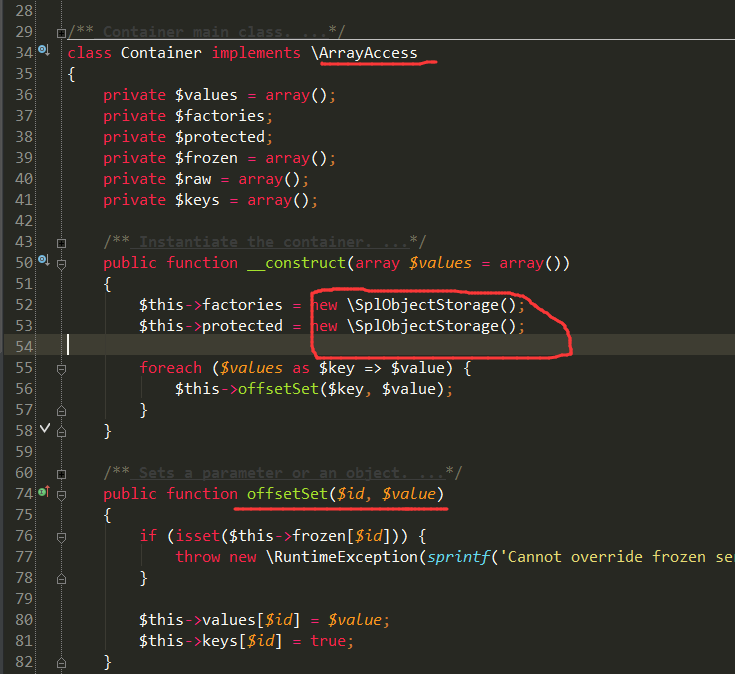最近這段時間回家過年了,博客也沒有更新,感覺少學習了好多東西,也錯失了好多的學習機會,就像大家在春節搶紅包時常說的一句話:一不留神錯過了好幾億。廢話少說,這篇博客給大家說說關於PHP預定義接口中常用到的重量級人物: ArrayAccess。大家也許會問,最基本、最常用的預定義接口有6個呢,為啥非得說這個。從日常的使用情況來看:這個出現的頻率非常高,特別是在框架中,比如Laravel、Slim等都會用到,並且用得非常經典,讓人佩服啊。從技術上說:說實話其他的我用的少啊!只是知道簡單的用法,對他的理解比較淺顯,不敢在這裡誤導大家,哈哈!今天我要寫的內容也不一定都正確,不對之處還請指正。
ArrayAccess
先說 ArrayAccess 吧!ArrayAccess 的作用是使得你的對象可以像數組一樣可以被訪問。應該說 ArrayAccess 在PHP5中才開始有的,PHP5中加入了很多新的特性,當然也使類的重載也加強了,PHP5 中添加了一系列接口,這些接口和實現的 Class 統稱為 SPL。
ArrayAccess 這個接口定義了4個必須要實現的方法:
1 {
2 abstract public offsetExists ($offset) //檢查偏移位置是否存在
3 abstract public offsetGet ($offset) //獲取一個偏移位置的值
4 abstract public void offsetSet ($offset ,$value) //設置一個偏移位置的值
5 abstract public void offsetUnset ($offset) //復位一個偏移位置的值
6 }
所以我們要使用ArrayAccess這個接口,就要實現相應的方法,這幾個方法不是隨便寫的,我們可以看一下 ArrayAccess 的原型:
1 /**
2 * Interface to provide accessing objects as arrays.
3 * @link http://php.net/manual/en/class.arrayaccess.php
4 */
5 interface ArrayAccess {
6
7 /**
8 * (PHP 5 >= 5.0.0)<br/>
9 * Whether a offset exists
10 * @link http://php.net/manual/en/arrayaccess.offsetexists.php
11 * @param mixed $offset <p>
12 * An offset to check for.
13 * </p>
14 * @return boolean true on success or false on failure.
15 * </p>
16 * <p>
17 * The return value will be casted to boolean if non-boolean was returned.
18 */
19 public function offsetExists($offset);
20
21 /**
22 * (PHP 5 >= 5.0.0)<br/>
23 * Offset to retrieve
24 * @link http://php.net/manual/en/arrayaccess.offsetget.php
25 * @param mixed $offset <p>
26 * The offset to retrieve.
27 * </p>
28 * @return mixed Can return all value types.
29 */
30 public function offsetGet($offset);
31
32 /**
33 * (PHP 5 >= 5.0.0)<br/>
34 * Offset to set
35 * @link http://php.net/manual/en/arrayaccess.offsetset.php
36 * @param mixed $offset <p>
37 * The offset to assign the value to.
38 * </p>
39 * @param mixed $value <p>
40 * The value to set.
41 * </p>
42 * @return void
43 */
44 public function offsetSet($offset, $value);
45
46 /**
47 * (PHP 5 >= 5.0.0)<br/>
48 * Offset to unset
49 * @link http://php.net/manual/en/arrayaccess.offsetunset.php
50 * @param mixed $offset <p>
51 * The offset to unset.
52 * </p>
53 * @return void
54 */
55 public function offsetUnset($offset);
56 }
下面我們可以寫一個例子,非常簡單:
1 <?php
2 class Test implements ArrayAccess
3 {
4 private $testData;
5
6 public function offsetExists($key)
7 {
8 return isset($this->testData[$key]);
9 }
10
11 public function offsetSet($key, $value)
12 {
13 $this->testData[$key] = $value;
14 }
15
16 public function offsetGet($key)
17 {
18 return $this->testData[$key];
19 }
20
21 public function offsetUnset($key)
22 {
23 unset($this->testData[$key]);
24 }
25 }
26
27 $obj = new Test();
28
29 //自動調用offsetSet方法
30 $obj['data'] = 'data';
31
32 //自動調用offsetExists
33 if(isset($obj['data'])){
34 echo 'has setting!';
35 }
36 //自動調用offsetGet
37 var_dump($obj['data']);
38
39 //自動調用offsetUnset
40 unset($obj['data']);
41 var_dump($test['data']);
42
43 //輸出:
44 //has setting!
45 //data
46 //null
好了,下面我們會結合Slim框架來說在實際中的應用,在Slim中使用非常重要,也非常出色的使用了 container,container繼承自Pimple\Container,說到這,就有必要說一下Pimple,pimple是php社區中比較流行的一種ioc容器,pimple中的container類使用了依賴注入的方式來實現實現了程序間的低耦合,可以用composer添加 require "pimple/pimple": "1.*" 添加Pimple到依賴類庫,Pimple還是要多看看的,就一個文件,在程序整個生命周期中,各種屬性、方法、對象、閉包都可以注冊其中,但pimple只是實現了一個容器的概念,還有好多依賴注入、自動創建、關聯等功能需要看Laravel才能深刻學到。
在Slim中它使用 container 的類實現了將配置文件依次加載,可以像訪問數組一樣訪問他們,包括displayErrorDetails,renderer, logger,httpVersion,responseChunkSize,outputBuffering,determineRouteBeforeAppMiddleware,displayErrorDetails等等,使他們在框架加載的時候首先被加載。使用的時候直接取就可以了,
下面就是這種加載機制:
<?php
namespace Slim;
use Interop\Container\ContainerInterface;
use Interop\Container\Exception\ContainerException;
use Pimple\Container as PimpleContainer;
use Psr\Http\Message\ResponseInterface;
use Psr\Http\Message\ServerRequestInterface;
use Slim\Exception\ContainerValueNotFoundException;
class Container extends PimpleContainer implements ContainerInterface
{
/**
* Default settings
*
* @var array
*/
private $defaultSettings = [
'httpVersion' => '1.1',
'responseChunkSize' => 4096,
'outputBuffering' => 'append',
'determineRouteBeforeAppMiddleware' => false,
'displayErrorDetails' => false,
];
/**
* Create new container
*
* @param array $values The parameters or objects.
*/
public function __construct(array $values = [])
{
//var_dump($values); exit;
parent::__construct($values);
$userSettings = isset($values['settings']) ? $values['settings'] : [];
$this->registerDefaultServices($userSettings);
}
private function registerDefaultServices($userSettings)
{
$defaultSettings = $this->defaultSettings;
$this['settings'] = function () use ($userSettings, $defaultSettings) {
return new Collection(array_merge($defaultSettings, $userSettings));
};
$defaultProvider = new DefaultServicesProvider();
$defaultProvider->register($this);
}
. . .
}
其中 defaultSettings 為系統默認配置,userSettings為用戶的配置,比如日志,模板等。
下面這段是offsetGet,巧妙使用鍵值來判斷該值是否已經設置過,如果設置過就會直接去取了,沒有設置就會轉到設置的邏輯。
1 public function offsetGet($id)
2 {
3 if (!isset($this->keys[$id])) {
4 throw new \InvalidArgumentException(sprintf('Identifier "%s" is not defined.', $id));
5 }
6
7 if (
8 isset($this->raw[$id])
9 || !is_object($this->values[$id])
10 || isset($this->protected[$this->values[$id]])
11 || !method_exists($this->values[$id], '__invoke')
12 ) {
13 return $this->values[$id];
14 }
15
16 if (isset($this->factories[$this->values[$id]])) {
17 return $this->values[$id]($this);
18 }
19
20 $raw = $this->values[$id];
21 $val = $this->values[$id] = $raw($this);
22 $this->raw[$id] = $raw;
23
24 $this->frozen[$id] = true;
25
26 return $val;
27 }
我們再看看 PimpleContainer,如下圖:

我們可以看到其中有個 SplObjectStorage,需要說一下這個,SplObjectStorage是用來存儲一組對象,當你需要唯一標識對象的時候。按照官網的說法 PHP SPL SplObjectStorage類實現了Countable, Iterator, Serializable, ArrayAccess四個接口,可實現統計、迭代、序列化、數組式訪問等功能。所以SplObjectStorage是一個標准的對象容器。
說到這大家對ArrayAccess應該有所了解了,如果還不清楚,可以多看看Slim的源碼,上面寫的比較清楚,而且那套源碼及其的簡練,值得我們學習。
博客會同步更新到我的個人網站,歡迎大家訪問!
轉載請注明出處,後面會持續更新,謝謝大家!